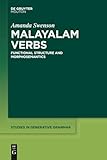Malayalam Verbs : Functional Structure and Morphosemantics / Amanda Swenson.
Material type: TextSeries: Studies in Generative Grammar [SGG] ; 137Publisher: Berlin ; Boston : De Gruyter Mouton, [2019]Copyright date: ©2019Description: 1 online resource (XI, 270 p.)Content type:
TextSeries: Studies in Generative Grammar [SGG] ; 137Publisher: Berlin ; Boston : De Gruyter Mouton, [2019]Copyright date: ©2019Description: 1 online resource (XI, 270 p.)Content type: - 9781501516917
- 9781501510120
- 9781501510144
- 494.8/12 23
- PL4713 .S816 2019
- online - DeGruyter
- Issued also in print.
| Item type | Current library | Call number | URL | Status | Notes | Barcode | |
|---|---|---|---|---|---|---|---|
 eBook
eBook
|
Biblioteca "Angelicum" Pont. Univ. S.Tommaso d'Aquino Nuvola online | online - DeGruyter (Browse shelf(Opens below)) | Online access | Not for loan (Accesso limitato) | Accesso per gli utenti autorizzati / Access for authorized users | (dgr)9781501510144 |
Frontmatter -- Preface -- Contents -- 1. Introduction -- 2. The Puzzle of Tense in Malayalam: A Cross-linguistic Perspective -- 3. Tense in Malayalam: Debunking Potential Arguments from Non-finite Forms -- 4. Viewpoint Aspect in Malayalam -- 5. Cross-linguistic variation in the perfect -- 6 .The Syntax and Semantics of Copulas in Malayalam -- 7. Conclusion -- References -- Author index -- Language index -- Subject index
restricted access online access with authorization star
http://purl.org/coar/access_right/c_16ec
This book, using Malayalam as a case study, provides an in-depth exploration of how inflectional suffixes should be separated from the verb and the implications this has for the syntax and semantics. Past work has proposed that Malayalam lacks a Tense Phrase and tense morphology, i.e. is ‘tenseless’. However, this book shows that Malayalam behaves differently from other tenseless languages and that it does have tense morphology. It also provides evidence that there is a Tense Phrase in the syntax. In addition, it examines what have been called the two 'imperfectives' and argues that one is a type of progressive, while the other is a pluractional marker and shows that Malayalam lacks perfect morphology and a Perfect Phrase in, minimally, Universal perfects. With respect to finiteness, among other things, it argues that Conjunctive Participles are best analyzed as a type of absolutive adjunct and that -athu ‘gerunds’ involve nominalization above the Tense Phrase-level. This book will be a valuable resource for anyone interested in cross-linguistic variation in Tense-Aspect-Modality and/or the morphosyntax or morphosemantics of Dravidian languages.
Issued also in print.
Mode of access: Internet via World Wide Web.
In English.
Description based on online resource; title from PDF title page (publisher's Web site, viewed 25. Jun 2024)


